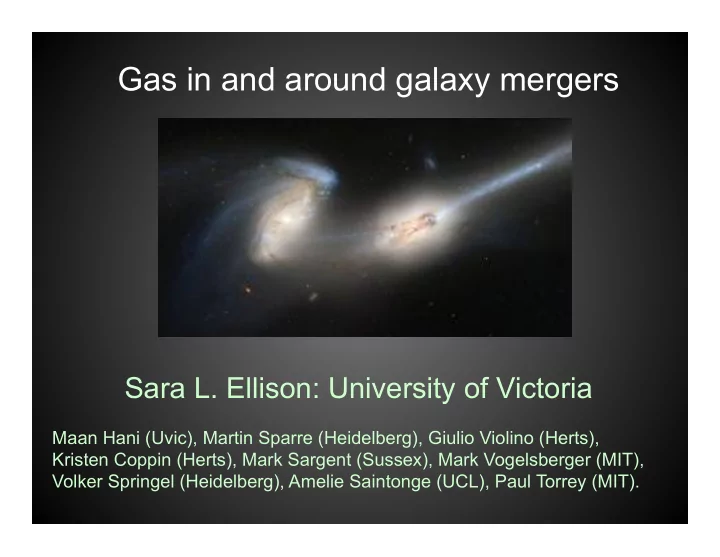

Gas in and around galaxy mergers Sara L. Ellison: University of Victoria Maan Hani (Uvic), Martin Sparre (Heidelberg), Giulio Violino (Herts), Kristen Coppin (Herts), Mark Sargent (Sussex), Mark Vogelsberger (MIT), Volker Springel (Heidelberg), Amelie Saintonge (UCL), Paul Torrey (MIT).
The effects of gas flows in mergers: Torrey et al. (2012) Di Matteo et al (2005) Simulations predict interactions should boost star formation, reduce central metallicity and increase nuclear activity.
Observational tests of merger induced transformations: Galaxy pairs in the SDSS 14,000 pairs from SDSS: Projected separation <80 kpc Δ V <300 km/s Mass ratio 0.1 – 10 97 post-mergers from Galaxy Zoo And stellar mass matched control samples
Observational confirmation of theoretical predictions using SDSS Log SFR enhancement Asymmetry enhancement Log O/H enhancement E.g. Ellison et al. 2008, 2011, 2013; Scudder et al. 2012; Patton et al. 2016
No evidence that mergers consume their global gas reservoir Log f gas(merger) – log f gas(control) Molecular gas reservoir is boosted in mergers by factor 2-3 Ellison et al (2015); Violino, Ellison et al. (submitted)
Studying the CGM with galaxy simulations Led by PhD student Maan Hani (Uvic) Zoom-in simulation of a merger selected from Illustris, re-run at 40x • resolution (Sparre & Springel 2016). • Major merger (mass ratio = 1:1.16) at z=0.66 resulting in a Milky Way mass galaxy at z=0. • Physics model (Grand et al. 2016, Marrinacci et al 2014, Vogelsberger et al 2013): • Metal enrichment from SNIa, SNII, AGB • SN feedback • AGN feedback (quasar and radio mode) • Radiative heating (UVB, AGN) and cooling (primordial and metal)
CGM size evolution Covering fraction of H and metals increases after a merger and is long lived. Hani, Sparre, Ellison et al. (in prep)
CGM metallicity evolution 6.58Gyr 7.69Gyr 8.98Gyr redshift 1 0.5 0 0 . 8 0 . 6 ∆ log(O/H) 0 . 4 R ∈ [0 , 10] kpc 0 . 2 R ∈ [75 , 100] kpc R ∈ [100 , 150] kpc 0 . 0 − 0 . 2 − 0 . 4 6 7 8 9 10 11 12 13 14 Age of the Universe [Gyr] Long lived factor of ~2 increase in CGM metallicity Hani, Sparre, Ellison et al. (in prep)
Lower covering fraction of most commonly observed species 1 . 8 log(N HI ) = 17.0 log(N CIV ) = 13.0 log(N OVI ) = 14.0 1 . 5 1 . 2 C.F. 0 . 9 0 . 6 0 . 3 0 . 0 46 log(L bol [erg/s]) 44 42 40 Radio 38 Quasar 40 SFR [M � /yr] 30 20 10 7 8 9 10 11 12 13 14 Age of the Universe [Gyr] Hani, Sparre, Ellison et al. (in prep)
Future work Simulated spectra through CGM-merger simulations. • • Larger merger simulation suite to investigate effect of orbits and mass ratios. • Observational tests of theoretical predictions: 34 orbits with COS (Cycle 22, PI Bordoloi) to study sightlines through 11 galaxy pairs.
Summary • Mergers can trigger AGN, enhance SFRs and dilute central metallicity: Ellison et al. (2008, 2011, 2013); Scudder et al. 2012. • Mergers do not significantly deplete their global gas reservoir and molecular gas fraction is boosted: Ellison et al. 2015; Violino et al. (submitted). • Simulations show that mergers puff-up their CGM in both gas and metals: Hani et al. (in prep). • Simulations also predict a long-lived factor of ~2 metallicity enhancement in the CGM -> an effective way of putting metals into the CGM: Hani et al. (in prep).
Recommend
More recommend